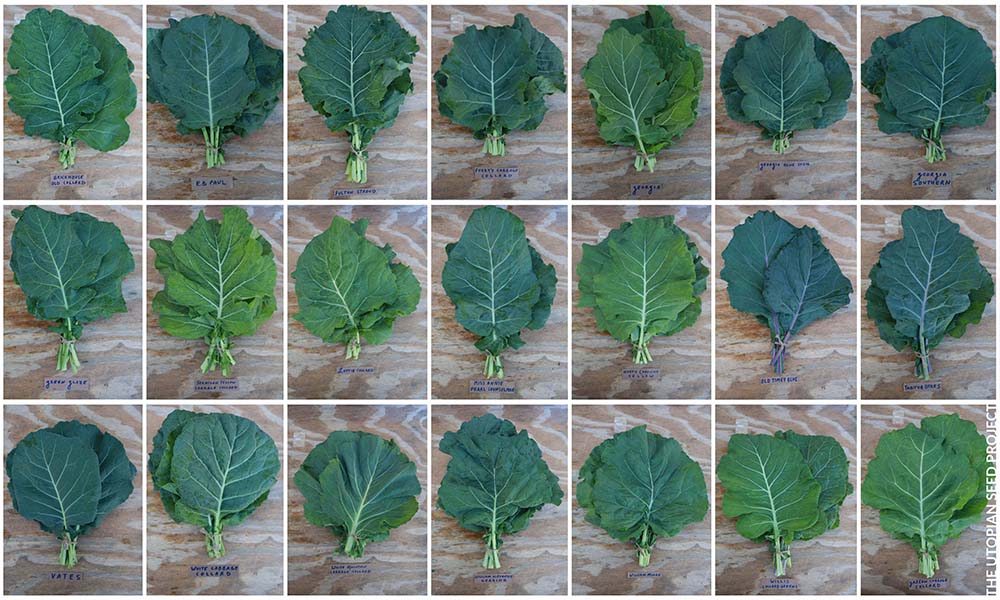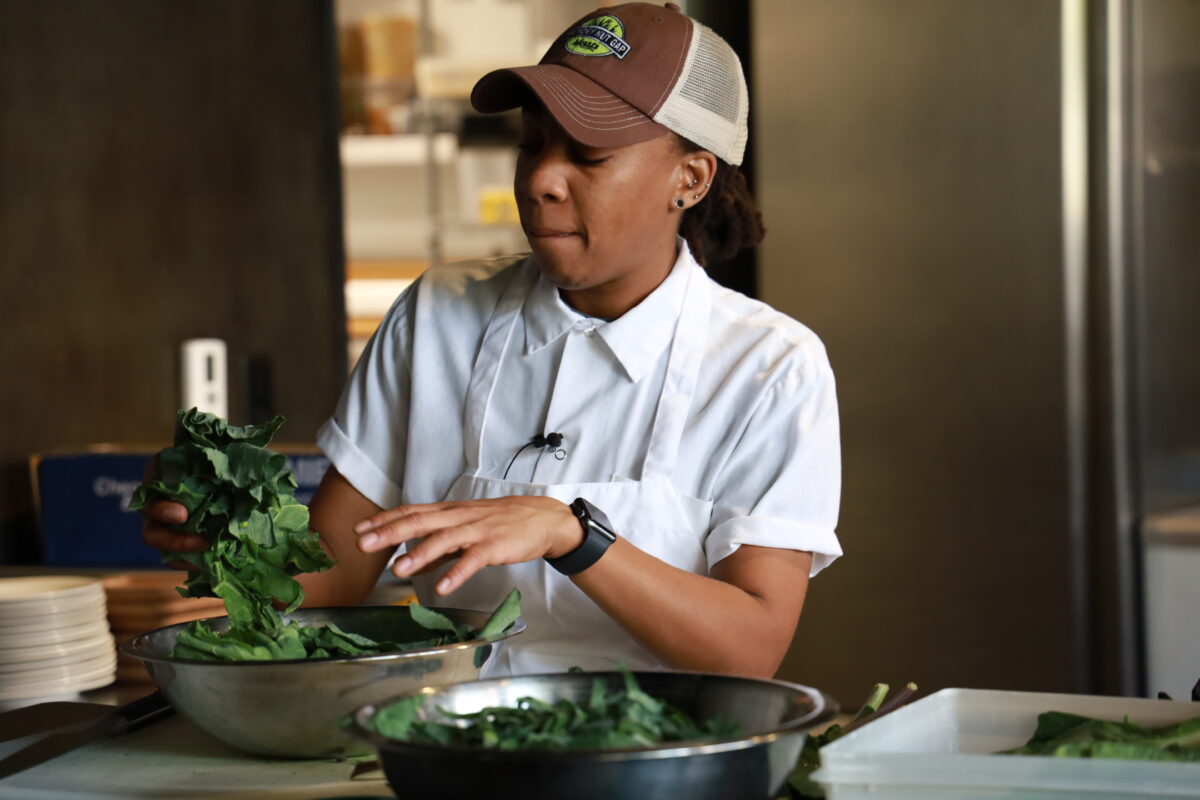Preserving the Future of Heirloom Collards
A national seed-saving project aims to celebrate the species’ genetic diversity while showcasing its historical importance.
Preserving the Future of Heirloom Collards
A national seed-saving project aims to celebrate the species’ genetic diversity while showcasing its historical importance.

The Heirloom Collard Project is testing to see how 20 collard varieties grow in different parts of the country.courtesy of the Heirloom Collard Project
Over the past decade, heirloom crops have made an incredible comeback, with growers embracing different varieties of tomatoes, beans, potatoes, carrots, apples and more. Now, a small movement is growing around preserving and promoting rare, nearly lost collard varieties.
The historical and cultural significance of collards run deep. Although they originated in Europe, collards (Brassica oleracea) are more often associated with Africa and the American South, where the cooking traditions of enslaved Africans made collard greens a regional specialty, and where heirloom varieties of the leafy green vegetable largely remained until recently.
The Heirloom Collard Project, a national effort first started in 2016, has built a network of gardeners and farmers committed to honoring and furthering this culinary tradition. Focusing on heirloom collard seeds that have been passed down from generation to generation, the project aims to expand the awareness of the old varieties nearly lost to the industrialization of agriculture, which has led to a 75-percent drop in overall crop genetic diversity.
“The cornerstone of this project is to get these varieties back into farms and gardens around the country, and to really celebrate them,” says Norah Hummel, seed bank manager at Seed Savers Exchange, one of several organizations collaborating on the initiative.
The project grew out of earlier work done by Edward Davis and John Morgan, professors of geography at Emory & Henry College in Virginia. In the early 2000s, Davis and Morgan took a road trip, traversing thousands of miles through southern states, from Arkansas to Florida and from Virginia to Louisiana. In search of heirloom collard seeds, they visited homes, gardens, grocers, farms and restaurants, amassing a collection of more than 100 varieties of collards along the way.
“One thing they noticed about these seed stewards was that a lot of them were older, were in their 60s and 70s, and they didn’t necessarily have a plan for who they were going to share these varieties with,” says Hummel. “They saw this collection trip as an act of preservation, preserving these varieties for future generations.”
Davis and Morgan later donated their seed collection to the USDA’s seed bank, called the National Plant Germplasm Collection, where the federal government stores and preserves hundreds of thousands of varieties. The duo’s research culminated in the 2015 book Collards: A Southern Tradition From Seed to Table, in which they share stories of the nearly lost cultivars and the stewards who saved their seeds.

When Ira Wallace of the Southern Exposure Seed Exchange, a worker-run co-operative focused on heirloom and open-pollinated seeds, found out about the USDA’s collection of collard seeds, she set out to revive their legacy in gardens across America. In 2016, she requested 60 heirloom varieties and got in touch with Seed Savers Exchange to test trials at their Heritage Farm in Decorah, Iowa.
The Iowa farm planted them all, collecting data about how the varieties grew, as well as cooking them up and recording tasting notes. “We saw this incredible diversity in these plants,” says Hummel. “We wanted to increase access and share not only the seed but the historical information and stories of these varieties.”
Last year, the Heirloom Collard Project opened up access to a wider group of farmers and gardeners, who participated in a trial growing project to track how 20 different heirloom varieties grew in various parts of the country. More than 250 growers participated, many of whom were gardeners looking for something to do while confined to their homes during quarantine. Twenty varieties—with names such as Ole Timey Blue, North Carolina Yellow, Miss Annie Pearl Counselman and Green Glaze—were selected for the trial.
Growers were sent seeds for three heirloom varieties, chosen randomly, and asked that they share their experience of growing them. There were also eight full trial sites that received seeds for all 20 varieties, which they grew on different farms in states including North Carolina, Virginia, Georgia, Florida, Washington and Oregon. Using a database created by Seedlinked, all participants recorded data for uniformity, appearance, flavor, vigor, disease resistance, germination, winter hardiness, earliness and yield. Seed Savers Exchange plans to share the results of the trial project soon, so farmers and gardeners can learn more about the heirloom varieties and choose which ones to grow themselves.
Farmer Melony Edwards was one of the participants running a full trial site, growing all 20 heirloom cultivars on her 20-acre Washington State farm, Ebony by Nature. “We already know that these collard varieties perform well in the southern United States,” she wrote in a piece about the success of her collard-growing experience. “However, there is great value in trialing in the [Pacific Northwest] to learn which of these varieties will thrive in our cooler climate.”
While farmers are focused on the preservation of these heirloom varieties, author Chris Smith says it’s equally as important to show chefs how to cook with these varieties in order to ensure their future success. “Saving seeds for the sake of saving seeds is a little close-minded,” says Smith, who is the executive director of the Asheville, North Carolina-based Utopian Seed Project and author of the James Beard Award-winning book, The Whole Okra.
To further promote and celebrate collard culinary traditions, Smith works with local restaurants and chefs such as Ashleigh Shanti, who gave a cooking demo for attendees of the virtual Collard Week last October.
Seed Savers Exchange’s Hummel is excited to see this new generation of seed-saving stewards express an interest in growing and eating heirloom collards. “They have so much history and significance,” she says, “and they are so important to the people who stewarded them.”
Follow us
This work is licensed under a Creative Commons Attribution-NoDerivatives 4.0 International License.
Want to republish a Modern Farmer story?
We are happy for Modern Farmer stories to be shared, and encourage you to republish our articles for your audience. When doing so, we ask that you follow these guidelines:
Please credit us and our writers
For the author byline, please use “Author Name, Modern Farmer.” At the top of our stories, if on the web, please include this text and link: “This story was originally published by Modern Farmer.”
Please make sure to include a link back to either our home page or the article URL.
At the bottom of the story, please include the following text:
“Modern Farmer is a nonprofit initiative dedicated to raising awareness and catalyzing action at the intersection of food, agriculture, and society. Read more at <link>Modern Farmer</link>.”
Use our widget
We’d like to be able to track our stories, so we ask that if you republish our content, you do so using our widget (located on the left hand side of the article). The HTML code has a built-in tracker that tells us the data and domain where the story was published, as well as view counts.
Check the image requirements
It’s your responsibility to confirm you're licensed to republish images in our articles. Some images, such as those from commercial providers, don't allow their images to be republished without permission or payment. Copyright terms are generally listed in the image caption and attribution. You are welcome to omit our images or substitute with your own. Charts and interactive graphics follow the same rules.
Don’t change too much. Or, ask us first.
Articles must be republished in their entirety. It’s okay to change references to time (“today” to “yesterday”) or location (“Iowa City, IA” to “here”). But please keep everything else the same.
If you feel strongly that a more material edit needs to be made, get in touch with us at [email protected]. We’re happy to discuss it with the original author, but we must have prior approval for changes before publication.
Special cases
Extracts. You may run the first few lines or paragraphs of the article and then say: “Read the full article at Modern Farmer” with a link back to the original article.
Quotes. You may quote authors provided you include a link back to the article URL.
Translations. These require writer approval. To inquire about translation of a Modern Farmer article, contact us at [email protected]
Signed consent / copyright release forms. These are not required, provided you are following these guidelines.
Print. Articles can be republished in print under these same rules, with the exception that you do not need to include the links.
Tag us
When sharing the story on social media, please tag us using the following: - Twitter (@ModFarm) - Facebook (@ModernFarmerMedia) - Instagram (@modfarm)
Use our content respectfully
Modern Farmer is a nonprofit and as such we share our content for free and in good faith in order to reach new audiences. Respectfully,
No selling ads against our stories. It’s okay to put our stories on pages with ads.
Don’t republish our material wholesale, or automatically; you need to select stories to be republished individually.
You have no rights to sell, license, syndicate, or otherwise represent yourself as the authorized owner of our material to any third parties. This means that you cannot actively publish or submit our work for syndication to third party platforms or apps like Apple News or Google News. We understand that publishers cannot fully control when certain third parties automatically summarize or crawl content from publishers’ own sites.
Keep in touch
We want to hear from you if you love Modern Farmer content, have a collaboration idea, or anything else to share. As a nonprofit outlet, we work in service of our community and are always open to comments, feedback, and ideas. Contact us at [email protected].by Shelby Vittek, Modern Farmer
May 21, 2021
Modern Farmer Weekly
Solutions Hub
Innovations, ideas and inspiration. Actionable solutions for a resilient food system.
ExploreExplore other topics
Share With Us
We want to hear from Modern Farmer readers who have thoughtful commentary, actionable solutions, or helpful ideas to share.
SubmitNecessary cookies are absolutely essential for the website to function properly. This category only includes cookies that ensures basic functionalities and security features of the website. These cookies do not store any personal information.
Any cookies that may not be particularly necessary for the website to function and are used specifically to collect user personal data via analytics, ads, other embedded contents are termed as non-necessary cookies.
This phrase bothers me – “the project aims to expand the awareness of the old varieties nearly lost to the industrialization of agriculture, which has led to a 75-percent drop in overall crop genetic diversity.” Being an Iowa farm girl, I’m used to industrial agriculture referring to the big money crops like corn and soybeans. But collards being a big money crop? I don’t know. Perhaps Burpee bred the collards that grow the best in a variety of conditions?